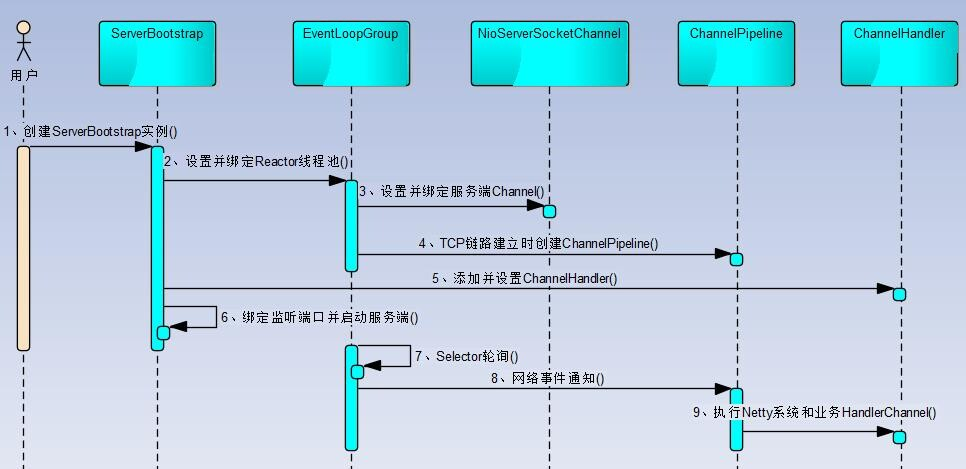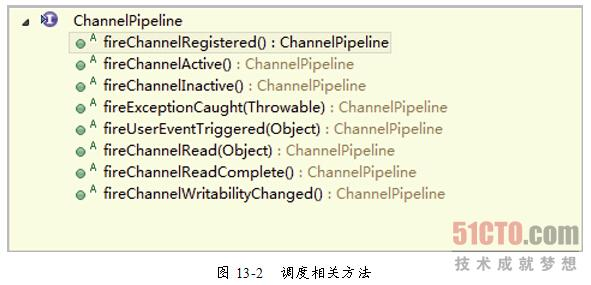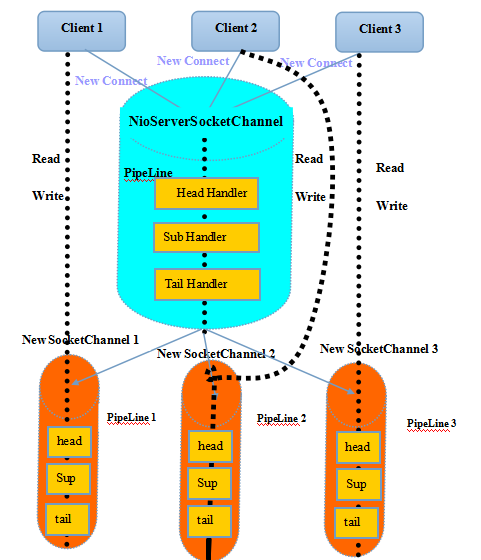原生的NIO类图使用有诸多不便,Netty向用户屏蔽了细节,在与用户交界处做了封装。
一、服务端创建时序图

步骤一:创建ServerBootstrap实例
ServerBootstrap是Netty服务端的启动辅助类,它提供了一些列的方法用于设置参数,由于参数太多,使用builder模式。
步骤二:设置并且绑定好Reactor线程池
Netty中的Reactor线程池是EventLoopGroup,它实际上就是EventLoop数组。EventLoop的职责是处理所有注册到本线程多路复用器Selector上的Channel。Selector的轮询操作由绑定的EventLoop线程run方法驱动,在一个循环体内循环执行。值得说明的是,EventLoop的职责不仅仅是处理网络I/O事件,用户自定义的Task和定时任务Task也统一由EventLoop负责处理,这样线程模型就实现了统一。从调度层面看,也不存在从EvenetLoop线程中再启动其他类型的线程用于异步执行另外的任务,这样就避免了多线程的并发操作和锁竞争,提升了I/O线程的处理和调度性能。
步骤三:设置并绑定服务端Channel
服务端需要创建ServerSocketChannel,对原生NIO类库进行了封装,对应是NioServerSocketChannel
对用户而言,不需要关心服务端Channel的底层实现细节和工作原理,只需要指定具体是哪种服务端
Netty的ServerBootstrap提供了channel方法用于指定服务端Channel的类型。Netty通过工厂反射创建NioServerSocketChannel对象。
public B channel(Class<? extends C> channelClass) { if (channelClass == null) { throw new NullPointerException("channelClass"); } return channelFactory(new ReflectiveChannelFactory<C>(channelClass)); }
步骤四:链路建立的时候创建并且初始化ChannelPipeline。
它本质上是一个负载处理网络事件的职责链,负载管理和执行ChannelHanler。网络事件以事件流的形式在ChannelPipeline中流转,由ChannelPipeline根据ChannelHandler的执行策略调度ChannelHandler的执行。典型的网络事件如下:
(1)链路注册;
(2)链路激活;
(3)链路断开;
(4)接收到请求消息;
(5)请求消息接收并处理完毕;
(6)发送应答消息;
(7)链路发生异常;
(8)发生用户自定义事件。
步骤五:初始化ChannelPipeline完成之后,添加并设置ChannelHandler。
ChannelHandler是Netty提供给用户定制和扩展的关键接口。利用ChannelHandler用户可以完成大多数的功能定制,例如消息编解码、心跳、安全认证、TSL/SSL认证、流量控制和流量整形等。Netty同时也提供了大量的系统ChannelHandler供用户使用,比较实用的系统ChannelHandler总结如下:
(1)系统编解码框架——ByteToMessageCodec;
(2)通用基于长度的半包解码器——LengthFieldBasedFrameDecoder;
(3)码流日志打印Handler——LoggingHandler;
(4)SSL安全认证Handler——SslHandler;
(5)链路空闲检测Handler——IdleStateHandler;
(6)流量整形Handler——ChannelTrafficShapingHandler;
(7)Base64编解码——Base64Decoder和Base64Encoder。
.childHandler(new ChannelInitializer<SocketChannel>() { @Override public void initChannel(SocketChannel ch) throws Exception { ch.pipeline().addLast( new EchoServerHandler()); } });
步骤6:绑定并启动监听端口。
在绑定监听端口之前系统会做一系列的初始化和检测工作,完成之后,会启动监听端口,并将ServerSocketChannel注册到Selector上监听客户端连接,相关代码如下。
public ChannelFuture bind(SocketAddress localAddress) { validate(); if (localAddress == null) { throw new NullPointerException("localAddress"); } return doBind(localAddress); }
步骤7:Selector轮询。
由Reactor线程NioEventLoop负责调度和执行Selector轮询操作,选择准备就绪的Channel集合,相关代码如下
private void select(boolean oldWakenUp) throws IOException { Selector selector = this.selector; try { //此处代码省略... int selectedKeys = selector.select(timeoutMillis); selectCnt ++; //此处代码省略...
步骤8:当轮询到准备就绪的Channel之后,就由Reactor线程NioEventLoop执行ChannelPipeline的相应方法,最终调度并执行ChannelHandler

步骤9:执行Netty系统ChannelHandler和用户添加定制的ChannelHandler。
ChannelPipeline根据网络事件的类型,调度并执行ChannelHandler,相关代码如下。
public ChannelHandlerContext fireChannelRead(final Object msg) { invokeChannelRead(findContextInbound(), msg); return this; }
二、Netty服务端创建源码分析
1. 创建线程组:
通常会创建两个EventLoopGroup,也可以只创建一个并共享。
EventLoopGroup bossGroup = new NioEventLoopGroup(); EventLoopGroup workerGroup = new NioEventLoopGroup();
NioEventLoopGroup实际就是Reactor线程池,负责调度和执行具体的任务:
client接入
网络读写事件处理
用户自定义任务
定时任务
通过ServerBootstrap的group方法将2个EventLoopGroup实例传入:
public ServerBootstrap group(EventLoopGroup parentGroup, EventLoopGroup childGroup) { //1. 调用父类的group方法传入parentGroup super.group(parentGroup); //2. 设置childGroup if (childGroup == null) { throw new NullPointerException("childGroup"); } if (this.childGroup != null) { throw new IllegalStateException("childGroup set already"); } this.childGroup = childGroup; return this; }
如果只传一个参数,则2个线程池会被重用。
public ServerBootstrap group(EventLoopGroup group) { return group(group, group); }
2. 设置服务端Channel用于端口监听和客户端链路接入:
根据传入的channel class创建对应的服务端Channel,调用的是ReflectiveChannelFactory
public class ReflectiveChannelFactory<T extends Channel> implements ChannelFactory<T> { private final Class<? extends T> clazz; public ReflectiveChannelFactory(Class<? extends T> clazz) { if (clazz == null) { throw new NullPointerException("clazz"); } this.clazz = clazz; } @Override public T newChannel() { try { return clazz.newInstance(); } catch (Throwable t) { throw new ChannelException("Unable to create Channel from class " + clazz, t); } } @Override public String toString() { return StringUtil.simpleClassName(clazz) + ".class"; } }
3. 下面要设定服务端TCP参数:
Netty使用一个LinkedHashMap来保存
private final Map<ChannelOption<?>, Object> options = new LinkedHashMap<ChannelOption<?>, Object>();
主要参数是TCP的backlog参数,底层C对应的接口为:
int listen(int fd, int backlog);
backlog指定了内核为此套接字接口排队的最大连接个数,内核要为套接字维护2个队列:未连接队列和已连接队列,根据TCP三路握手的三个分节分隔这2个队列。
服务器处于listen状态时,收到客户端syn分节(connect)时在未完成队列中创建一个新的条目,然后用三路握手的第二个分节即服务器的syn响应客户端,此条目在第三个分节到达前(客户端对服务器syn的ack)一直保留在未完成队列中,如果三路握手完成,该条目将从未完成连接队列搬到已完成队列尾部。
当进程调用accept时,从已完成队列中的头部取出一个条目给进程,当已完成队列为空时进程将进入睡眠,直到有条目在已完成队列中才唤醒。backlog则用来规定2个队列总和的最大值,大多数实现值为5,但是在高并发场景中显然不够,比如Lighttpd中此值达到128*8。需要设置此值更大原因是未完成连接队列可能因为客户端syn的到达以及等待握手第三个分节的到达延时而增大。Netty默认是100,用户可以调整。
4. 下面可以为启动辅助类和其父类分别指定Handler。

本质区别就是:
- ServerBootstrap中的Handler是NioServerSocketChannel使用的,所有连接该监听端口的客户端都会执行它;
- 父类AbstractBootstrap中的Handler是个工厂类,它为每个新接入的客户端都创建一个新的Handler;
5. 服务端启动的最后一步,就是绑定本地端口,启动服务:
private ChannelFuture doBind(final SocketAddress localAddress) { final ChannelFuture regFuture = initAndRegister(); final Channel channel = regFuture.channel(); if (regFuture.cause() != null) { return regFuture; } if (regFuture.isDone()) { // At this point we know that the registration was complete and successful. ChannelPromise promise = channel.newPromise(); doBind0(regFuture, channel, localAddress, promise); return promise; } else { // Registration future is almost always fulfilled already, but just in case it's not. final PendingRegistrationPromise promise = new PendingRegistrationPromise(channel); regFuture.addListener(new ChannelFutureListener() { @Override public void operationComplete(ChannelFuture future) throws Exception { Throwable cause = future.cause(); if (cause != null) { // Registration on the EventLoop failed so fail the ChannelPromise directly to not cause an // IllegalStateException once we try to access the EventLoop of the Channel. promise.setFailure(cause); } else { // Registration was successful, so set the correct executor to use. // See https://github.com/netty/netty/issues/2586 promise.registered(); doBind0(regFuture, channel, localAddress, promise); } } }); return promise; } }
看红色标注的initAndRegister方法:
调用 channelFactory.newChannel()常见NioServerSocketChannel
然后调用init(channel)方法,由具体子类实现,这里实现的子类是ServerBootrap.
final ChannelFuture initAndRegister() { Channel channel = null; try { channel = channelFactory.newChannel(); init(channel); } catch (Throwable t) { if (channel != null) { // channel can be null if newChannel crashed (eg SocketException("too many open files")) channel.unsafe().closeForcibly(); } // as the Channel is not registered yet we need to force the usage of the GlobalEventExecutor return new DefaultChannelPromise(channel, GlobalEventExecutor.INSTANCE).setFailure(t); } ChannelFuture regFuture = config().group().register(channel); if (regFuture.cause() != null) { if (channel.isRegistered()) { channel.close(); } else { channel.unsafe().closeForcibly(); } } // If we are here and the promise is not failed, it's one of the following cases: // 1) If we attempted registration from the event loop, the registration has been completed at this point. // i.e. It's safe to attempt bind() or connect() now because the channel has been registered. // 2) If we attempted registration from the other thread, the registration request has been successfully // added to the event loop's task queue for later execution. // i.e. It's safe to attempt bind() or connect() now: // because bind() or connect() will be executed *after* the scheduled registration task is executed // because register(), bind(), and connect() are all bound to the same thread. return regFuture; }
下面关注init方法,主要完成了以下功能:
(1). 设置Socket参数和NioServerSocketChannel的附加属性,代码如下:
final Map<ChannelOption<?>, Object> options = options0(); synchronized (options) { channel.config().setOptions(options); } final Map<AttributeKey<?>, Object> attrs = attrs0(); synchronized (attrs) { for (Entry<AttributeKey<?>, Object> e: attrs.entrySet()) { @SuppressWarnings("unchecked") AttributeKey<Object> key = (AttributeKey<Object>) e.getKey(); channel.attr(key).set(e.getValue()); } }
(2).将AbstractBootstrap的Handler添加到NioServerSocketChannel的ChannelPipeline中,将用于服务端注册的Handler ServerBootstrapAcceptor添加到ChannelPipeline中,代码如下:
p.addLast(new ChannelInitializer<Channel>() { @Override public void initChannel(Channel ch) throws Exception { final ChannelPipeline pipeline = ch.pipeline(); ChannelHandler handler = config.handler(); if (handler != null) { pipeline.addLast(handler); } // We add this handler via the EventLoop as the user may have used a ChannelInitializer as handler. // In this case the initChannel(...) method will only be called after this method returns. Because // of this we need to ensure we add our handler in a delayed fashion so all the users handler are // placed in front of the ServerBootstrapAcceptor. ch.eventLoop().execute(new Runnable() { @Override public void run() { pipeline.addLast(new ServerBootstrapAcceptor( currentChildGroup, currentChildHandler, currentChildOptions, currentChildAttrs)); } }); } });
到此处,Netty服务端监听的相关资源已经初始化完毕,就剩下最后一步-
6. 注册NioServerSocketChannel到Reactor线程的多路复用器上,然后轮询客户端连接事件。
在分析注册代码之前,我们先通过下图看看目前NioServerSocketChannel的ChannelPipeline的组成:

通过Debug最终发现在AbstractChannel类中的register方法上:
public final void register(EventLoop eventLoop, final ChannelPromise promise) { if (eventLoop == null) { throw new NullPointerException("eventLoop"); } if (isRegistered()) { promise.setFailure(new IllegalStateException("registered to an event loop already")); return; } if (!isCompatible(eventLoop)) { promise.setFailure( new IllegalStateException("incompatible event loop type: " + eventLoop.getClass().getName())); return; } AbstractChannel.this.eventLoop = eventLoop; if (eventLoop.inEventLoop()) { register0(promise); } else { try { eventLoop.execute(new Runnable() { @Override public void run() { register0(promise); } }); } catch (Throwable t) { logger.warn( "Force-closing a channel whose registration task was not accepted by an event loop: {}", AbstractChannel.this, t); closeForcibly(); closeFuture.setClosed(); safeSetFailure(promise, t); } } }
首先判断是否是NioEventLoop自身发起的操作,如果是,则不存在并发操作,直接执行Channel注册;如果由其它线程发起,则封装成一个Task放入消息队列中异步执行。此处,由于是由ServerBootstrap所在线程执行的注册操作,所以会将其封装成Task投递到NioEventLoop中执行:
private void register0(ChannelPromise promise) { try { // check if the channel is still open as it could be closed in the mean time when the register // call was outside of the eventLoop if (!promise.setUncancellable() || !ensureOpen(promise)) { return; } boolean firstRegistration = neverRegistered; doRegister(); neverRegistered = false; registered = true; // Ensure we call handlerAdded(...) before we actually notify the promise. This is needed as the // user may already fire events through the pipeline in the ChannelFutureListener. pipeline.invokeHandlerAddedIfNeeded(); safeSetSuccess(promise); pipeline.fireChannelRegistered(); // Only fire a channelActive if the channel has never been registered. This prevents firing // multiple channel actives if the channel is deregistered and re-registered. if (isActive()) { if (firstRegistration) { pipeline.fireChannelActive(); } else if (config().isAutoRead()) { // This channel was registered before and autoRead() is set. This means we need to begin read // again so that we process inbound data. // // See https://github.com/netty/netty/issues/4805 beginRead(); } } } catch (Throwable t) { // Close the channel directly to avoid FD leak. closeForcibly(); closeFuture.setClosed(); safeSetFailure(promise, t); } }
将NioServerSocketChannel注册到NioEventLoop的Selector上,代码如下:
protected void doRegister() throws Exception { boolean selected = false; for (;;) { try { selectionKey = javaChannel().register(eventLoop().selector, 0, this); return; } catch (CancelledKeyException e) { if (!selected) { // Force the Selector to select now as the "canceled" SelectionKey may still be // cached and not removed because no Select.select(..) operation was called yet. eventLoop().selectNow(); selected = true; } else { // We forced a select operation on the selector before but the SelectionKey is still cached // for whatever reason. JDK bug ? throw e; } } } }
大伙儿可能会很诧异,应该注册OP_ACCEPT(16)到多路复用器上,怎么注册0呢?0表示只注册,不监听任何网络操作。这样做的原因如下:
- 注册方法是多态的,它既可以被NioServerSocketChannel用来监听客户端的连接接入,也可以用来注册SocketChannel,用来监听网络读或者写操作;
- 通过SelectionKey的interestOps(int ops)方法可以方便的修改监听操作位。所以,此处注册需要获取SelectionKey并给AbstractNioChannel的成员变量selectionKey赋值。
注册成功之后,触发ChannelRegistered事件,方法如下:
doRegister(); neverRegistered = false; registered = true; // Ensure we call handlerAdded(...) before we actually notify the promise. This is needed as the // user may already fire events through the pipeline in the ChannelFutureListener. pipeline.invokeHandlerAddedIfNeeded(); safeSetSuccess(promise); pipeline.fireChannelRegistered();
Netty的HeadHandler不需要处理ChannelRegistered事件,所以,直接调用下一个Handler,当ChannelRegistered事件传递到TailHandler后结束,TailHandler也不关心ChannelRegistered事件。
ChannelRegistered事件传递完成后,判断ServerSocketChannel监听是否成功,如果成功,需要出发NioServerSocketChannel的ChannelActive事件,判断方法即isActive().
pipeline.fireChannelRegistered(); // Only fire a channelActive if the channel has never been registered. This prevents firing // multiple channel actives if the channel is deregistered and re-registered. if (isActive()) { if (firstRegistration) { pipeline.fireChannelActive(); } else if (config().isAutoRead()) { // This channel was registered before and autoRead() is set. This means we need to begin read // again so that we process inbound data. // // See https://github.com/netty/netty/issues/4805 beginRead(); } }
其中isActive()是一个多态方法,如果是服务端则,判断监听是否启动;如果是客户端,判断TCP连接是否完成。ChannelActive事件在ChannelPipeline()传递,完成之后根据配置决定是否自动触发Channel的读操作。
读方法最终到:
public final void beginRead() { assertEventLoop(); if (!isActive()) { return; } try { doBeginRead(); } catch (final Exception e) { invokeLater(new Runnable() { @Override public void run() { pipeline.fireExceptionCaught(e); } }); close(voidPromise()); } }
由于不同类型的Channel对读的准备工作不同,因此doBeginRead也是个多态方法。
对于NIO通信,无论是客户端,还是服务端,都要设置网络监听操作位为自己感兴趣的,对于NioServerSocketChannel感兴趣的是OP_ACCEPT(16),于是修改操作位:
@Override protected void doBeginRead() throws Exception { // Channel.read() or ChannelHandlerContext.read() was called final SelectionKey selectionKey = this.selectionKey; if (!selectionKey.isValid()) { return; } readPending = true; final int interestOps = selectionKey.interestOps(); if ((interestOps & readInterestOp) == 0) { selectionKey.interestOps(interestOps | readInterestOp); } }
某些情况下,当前监听的操作类型和Channel关心的网络事件是一致的,不需要重复注册,所以增加了&的判断。JDK SelectionKey有4种操作类型,分别为:
(1) OP_READ = 1 <<0;
(2) OP_WRTE = 1 <<2;
(3) OP_CONNECT = 1 <<3;
(4) OP_ACCEPT = 1 <<4;
此时,服务器监听启动部分源码已经分析结束。
三、客户端接入源码分析
负责处理网络读写、连接和客户端请求介入的Reactor线程就是NioEventLoop,下面分析如何处理新的客户端接入。
当多路复用器检测到新的Channel时候,默认执行processSelectedKeysOptimized方法.
private void processSelectedKeys() { if (selectedKeys != null) { processSelectedKeysOptimized(selectedKeys.flip()); } else { processSelectedKeysPlain(selector.selectedKeys()); } }
由于Channel的Attachment是NioServerSocketChannel,所以执行processSelectedKey方法。
if (a instanceof AbstractNioChannel) { processSelectedKey(k, (AbstractNioChannel) a); } else { @SuppressWarnings("unchecked") NioTask<SelectableChannel> task = (NioTask<SelectableChannel>) a; processSelectedKey(k, task); }
继续点入该方法debug,由于监听的是连接操作,会执行unsafe.read()方法。由于不同的Channel执行不同的操作,所以NioUnsafe被设计为接口。
debug发现使用的是:
其read()方法如下所示:
@Override public void read() { assert eventLoop().inEventLoop(); final ChannelConfig config = config(); final ChannelPipeline pipeline = pipeline(); final RecvByteBufAllocator.Handle allocHandle = unsafe().recvBufAllocHandle(); allocHandle.reset(config); boolean closed = false; Throwable exception = null; try { try { do { int localRead = doReadMessages(readBuf); if (localRead == 0) { break; } //代码省略... }
对doReadMessages方法进行分析,发现它实际就是接受新的客户端连接并且创建NioSocketChannel:
protected int doReadMessages(List<Object> buf) throws Exception { SocketChannel ch = javaChannel().accept(); try { if (ch != null) { buf.add(new NioSocketChannel(this, ch)); return 1; } } catch (Throwable t) { logger.warn("Failed to create a new channel from an accepted socket.", t); try { ch.close(); } catch (Throwable t2) { logger.warn("Failed to close a socket.", t2); } } return 0; }
接收到新的连接之后,触发ChannelPipeLine的ChannelRead方法,代码如下:
int size = readBuf.size(); for (int i = 0; i < size; i ++) { readPending = false; pipeline.fireChannelRead(readBuf.get(i)); }
于是触发pipeLine调用链,事件在ChannelPipeline中传递,执行ServerBootstrapAcceptor中的channelRead方法,代码如下:
public void channelRead(ChannelHandlerContext ctx, Object msg) { final Channel child = (Channel) msg; child.pipeline().addLast(childHandler); //(1) for (Entry<ChannelOption<?>, Object> e: childOptions) { try { if (!child.config().setOption((ChannelOption<Object>) e.getKey(), e.getValue())) { logger.warn("Unknown channel option: " + e); } } catch (Throwable t) { logger.warn("Failed to set a channel option: " + child, t); } } //(2) for (Entry<AttributeKey<?>, Object> e: childAttrs) { child.attr((AttributeKey<Object>) e.getKey()).set(e.getValue()); } //(3) try { childGroup.register(child).addListener(new ChannelFutureListener() { @Override public void operationComplete(ChannelFuture future) throws Exception { if (!future.isSuccess()) { forceClose(child, future.cause()); } } }); } catch (Throwable t) { forceClose(child, t); } }
上面方法主要分为3个步骤:
(1) 加入childHandler到客户端SocketChannel的ChannelPipeline中
(2) 设置SocketChannel的TCP参数
(3) 注册SocketChannel到多路复用器
注意这里register注册也是注册操作位为0.
执行完注册后,紧接着会触发ChannelReadComplete事件。
Netty的Header和Tailer本身不关于这个事件,因此ChannelReadComplete是直接透传, 执行完ChannelReadComplete后,接着执行PipeLine的read()方法,最终到HeadHandler的read()方法。read()方法在前面说过,会修改操作位,此时这里debug发现把操作位修改OP_READ。
此时,客户端连接处理完成,可以进行网络读写等I/O操作。
四、Netty客户端创建流程
1、用户线程创建Bootstrap
Bootstrap b = new Bootstrap();
Bootstrap是Socket客户端创建工具类,通过API设置创建客户端相关的参数,异步发起客户端连接。
2、创建处理客户端连接、IO读写的Reactor线程组NioEventLoopGroup
EventLoopGroup group = new NioEventLoopGroup();
3、通过Bootstrap的ChannelFactory和用户指定的Channel类型创建用于客户端连接的NioSocketChannel
b.group(group).channel(NioSocketChannel.class).option(ChannelOption.TCP_NODELAY, true)
此处的NioSocketChannel类似于Java NIO提供的SocketChannel。
4、创建默认的channel Handler pipeline
b.group(group).channel(NioSocketChannel.class).option(ChannelOption.TCP_NODELAY, true) .handler(new ChannelInitializer<SocketChannel>() { @Override public void initChannel(SocketChannel ch) throws Exception { ch.pipeline().addLast(new HelloClientHandler()); } });
用于调度和执行网络事件。
5、异步发起TCP连接
// 发起异步连接操作 ChannelFuture f = b.connect(host, port).sync();
SocketChannel执行connect()操作后有以下三种结果:
- 连接成功,然会true;
- 暂时没有连接上,服务器端没有返回ACK应答,连接结果不确定,返回false。此种结果下,需要将NioSocketChannel中的selectionKey设置为OP_CONNECT,监听连接结果;
- 接连失败,直接抛出I/O异常
6、注册对应的网络监听状态位到多路复用器
7、由多路复用器在I/O中轮询个Channel,处理连接结果
8、如果连接成功,设置Future结果,发送连接成功事件,触发ChannelPipeline执行
9、由ChannelPipeline调度执行系统和用户的ChannelHandler,执行业务逻辑
五、客户端创建源码分析
Netty客户端创建流程非常繁琐,这里只针对关键步骤进行分析。
5.1 客户端连接辅助类Bootstrap
1. 设置I/O线程组:只需要一个线程组EventLoopGroup
2. TCP参数设置:
public <T> B option(ChannelOption<T> option, T value) { if (option == null) { throw new NullPointerException("option"); } if (value == null) { synchronized (options) { options.remove(option); } } else { synchronized (options) { options.put(option, value); } } return (B) this; }
主要TCP参数如下:
- (1) SO_TIMEOUT: 控制读取操作将阻塞多少毫秒,如果返回值为0,计时器就被禁止了,该线程将被无限期阻塞。
- (2) SO_SNDBUF: 套接字使用的发送缓冲区大小
- (3) SO_RCVBUF: 套接字使用的接收缓冲区大小
- (4) SO_REUSEADDR : 是否允许重用端口
- (5) CONNECT_TIMEOUT_MILLIS: 客户端连接超时时间,原生NIO不提供该功能,Netty使用的是自定义连接超时定时器检测和超时控制
- (6) TCP_NODELAY : 是否使用Nagle算法
3. channel接口
同样使用反射创建NioSocketChannel
4. 设置Handler接口
Bootstrap为了简化Handler的编排,提供了ChannelInitializer,当TCP链路注册成功后,调用initChannel接口:
public final void channelRegistered(ChannelHandlerContext ctx) throws Exception { // Normally this method will never be called as handlerAdded(...) should call initChannel(...) and remove // the handler. if (initChannel(ctx)) { // we called initChannel(...) so we need to call now pipeline.fireChannelRegistered() to ensure we not // miss an event. ctx.pipeline().fireChannelRegistered(); } else { // Called initChannel(...) before which is the expected behavior, so just forward the event. ctx.fireChannelRegistered(); } }
其中InitChannel为抽象接口,即下面红色标注的代码,用户便是在这个方法中设置ChannelHandler:
private boolean initChannel(ChannelHandlerContext ctx) throws Exception { if (initMap.putIfAbsent(ctx, Boolean.TRUE) == null) { // Guard against re-entrance. try { initChannel((C) ctx.channel()); } catch (Throwable cause) { // Explicitly call exceptionCaught(...) as we removed the handler before calling initChannel(...). // We do so to prevent multiple calls to initChannel(...). exceptionCaught(ctx, cause); } finally { remove(ctx); } return true; } return false; }
5.2 客户端连接操作
1. 首先要创建和初始化NioSocketChannel
private ChannelFuture doResolveAndConnect(final SocketAddress remoteAddress, final SocketAddress localAddress) { final ChannelFuture regFuture = initAndRegister(); final Channel channel = regFuture.channel();
//.....
创建之后,初始化,然后在注册:
final ChannelFuture initAndRegister() { Channel channel = null; try { channel = channelFactory.newChannel(); init(channel); } catch (Throwable t) { if (channel != null) { // channel can be null if newChannel crashed (eg SocketException("too many open files")) channel.unsafe().closeForcibly(); } // as the Channel is not registered yet we need to force the usage of the GlobalEventExecutor return new DefaultChannelPromise(channel, GlobalEventExecutor.INSTANCE).setFailure(t); } ChannelFuture regFuture = config().group().register(channel); if (regFuture.cause() != null) { if (channel.isRegistered()) { channel.close(); } else { channel.unsafe().closeForcibly(); } } // If we are here and the promise is not failed, it's one of the following cases: // 1) If we attempted registration from the event loop, the registration has been completed at this point. // i.e. It's safe to attempt bind() or connect() now because the channel has been registered. // 2) If we attempted registration from the other thread, the registration request has been successfully // added to the event loop's task queue for later execution. // i.e. It's safe to attempt bind() or connect() now: // because bind() or connect() will be executed *after* the scheduled registration task is executed // because register(), bind(), and connect() are all bound to the same thread. return regFuture; }
2. 创建完成后,连接操作会异步执行,最终调用到HeadContext的connect方法.
public void connect( ChannelHandlerContext ctx, SocketAddress remoteAddress, SocketAddress localAddress, ChannelPromise promise) throws Exception { unsafe.connect(remoteAddress, localAddress, promise); }

的connect操作如下:
if (doConnect(remoteAddress, localAddress)) { fulfillConnectPromise(promise, wasActive); } else { //...
3. doConnect三种可能结果
- 连接成功,然会true;
- 暂时没有连接上,服务器端没有返回ACK应答,连接结果不确定,返回false。此种结果下,需要将NioSocketChannel中的selectionKey设置为OP_CONNECT,监听连接结果;
- 接连失败,直接抛出I/O异常
异步返回之后,需要判断连接结果,如果成功,则触发ChannelActive事件。最终会将NioSocketChannel中的selectionKey设置为SelectionKey.OP_READ,用于监听网络读操作。
5.3 异步连接结果通知
NioEventLoop的Selector轮询客户端连接Channel,当服务端返回应答后,进行判断。依旧是NioEventLoop中的processSelectedKey方法:
if ((readyOps & SelectionKey.OP_CONNECT) != 0) { // remove OP_CONNECT as otherwise Selector.select(..) will always return without blocking // See https://github.com/netty/netty/issues/924 int ops = k.interestOps(); ops &= ~SelectionKey.OP_CONNECT; k.interestOps(ops); unsafe.finishConnect(); }
下面分析finishConnect方法:
@Override public final void finishConnect() { // Note this method is invoked by the event loop only if the connection attempt was // neither cancelled nor timed out. assert eventLoop().inEventLoop(); try { boolean wasActive = isActive(); doFinishConnect(); //判断SocketChannel的连接结果,true表示成功 fulfillConnectPromise(connectPromise, wasActive); //触发链路激活 } catch (Throwable t) { fulfillConnectPromise(connectPromise, annotateConnectException(t, requestedRemoteAddress)); } finally { // Check for null as the connectTimeoutFuture is only created if a connectTimeoutMillis > 0 is used // See https://github.com/netty/netty/issues/1770 if (connectTimeoutFuture != null) { connectTimeoutFuture.cancel(false); } connectPromise = null; } }
fulfillConnectPromise方法则触发链路激活事件,并由ChannelPipeline进行传播:
private void fulfillConnectPromise(ChannelPromise promise, boolean wasActive) { if (promise == null) { // Closed via cancellation and the promise has been notified already. return; } // Get the state as trySuccess() may trigger an ChannelFutureListener that will close the Channel. // We still need to ensure we call fireChannelActive() in this case. boolean active = isActive(); // trySuccess() will return false if a user cancelled the connection attempt. boolean promiseSet = promise.trySuccess(); // Regardless if the connection attempt was cancelled, channelActive() event should be triggered, // because what happened is what happened. if (!wasActive && active) { pipeline().fireChannelActive(); } // If a user cancelled the connection attempt, close the channel, which is followed by channelInactive(). if (!promiseSet) { close(voidPromise()); } }
跟之前类似,将网络监听修改为读操作。
5.4 客户端连接超时机制
由Netty自己实现的客户端超时机制,在AbstractNioChannel的connect方法中:
public final void connect( final SocketAddress remoteAddress, final SocketAddress localAddress, final ChannelPromise promise) { if (!promise.setUncancellable() || !ensureOpen(promise)) { return; } try { if (connectPromise != null) { // Already a connect in process. throw new ConnectionPendingException(); } boolean wasActive = isActive(); if (doConnect(remoteAddress, localAddress)) { fulfillConnectPromise(promise, wasActive); } else { connectPromise = promise; requestedRemoteAddress = remoteAddress; // Schedule connect timeout. int connectTimeoutMillis = config().getConnectTimeoutMillis(); if (connectTimeoutMillis > 0) { connectTimeoutFuture = eventLoop().schedule(new Runnable() { @Override public void run() { ChannelPromise connectPromise = AbstractNioChannel.this.connectPromise; ConnectTimeoutException cause = new ConnectTimeoutException("connection timed out: " + remoteAddress); if (connectPromise != null && connectPromise.tryFailure(cause)) { close(voidPromise()); } } }, connectTimeoutMillis, TimeUnit.MILLISECONDS); } promise.addListener(new ChannelFutureListener() { @Override public void operationComplete(ChannelFuture future) throws Exception { if (future.isCancelled()) { if (connectTimeoutFuture != null) { connectTimeoutFuture.cancel(false); } connectPromise = null; close(voidPromise()); } } }); } } catch (Throwable t) { promise.tryFailure(annotateConnectException(t, remoteAddress)); closeIfClosed(); } }
一旦超时定时器执行,则说明客户端超时,构造异常,将异常结果设置到connectPromise中,同时关闭客户端句柄。
如果在超时之前获取结果,则直接删除定时器,防止其被触发。